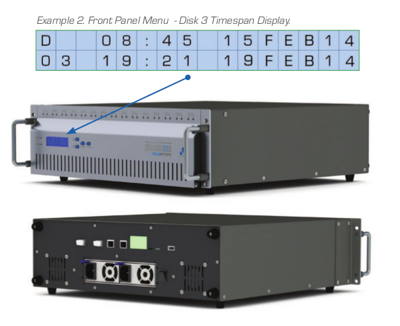Veracity: Coldstore Video Surveillance NAS
90TB, with sequential filing system using HDDs like video tapes
This is a Press Release edited by StorageNewsletter.com on February 20, 2015 at 2:55 pmVeracity USA, Inc. announced Coldstore, a NAS designed for video surveillance systems which need capacity for mega-pixel IP cameras and/or long archive periods.
 Designed for surveillance, this storage system achieves following features:
Designed for surveillance, this storage system achieves following features:
-
90TB capacity using around 60 watts – a 90% power saving versus RAID
-
Disk reliability even using the lowest cost disk drives available
-
No data loss on disk failure, with no rebuild required, and simple disk hot-swap
-
Sequential filing system (SFS) uses HDDs like video tapes
-
Uses any mix of SATA drive manufacturer, model and capacity
Simplicity
Whilst simple in concept and in use, the technology incorporated within Coldstore delivers a reliability system even when using the lowest costs disks. Linear Array of Idle Disks (LAID) system combined with Sequential Filing System (SFS) produces a system which provides massive capacities at low cost. The system is simple to manage, with all disk set up and configuration being automatic. The end-user can add, remove, replace and upgrade disks. These operations are done without ever stopping the recording of data.
Sequential recording
Disks are used sequentially, with all disks not in use being switched off, saving power and thus reducing temperature, vibration and wear – the three primary disk killers. The system uses a mirrored overlapping-pair writing pattern to provide data redundancy during the critical writing process, but not requiring twice the number of drives of fully-mirrored RAID-1 systems.
Power efficiency
Coldstore exploits the fact that only 3% of video data is ever replayed, and so every disk is off (on average) for 87% of the time. SFS controls the disk R/W heads, moving them across the disk very much like a vinyl record player, virtually removing disk vibration. Combining LAID and SFS together with a custom-designed low-power main CPU board results in a disk array which hardly needs any cooling at all, and uses as little as 60 watts even with a fully populated 90TB array.
As there are special times when it may be necessary to run all the drives simultaneously for an extended period (e.g. during a mass search process), Coldstore is designed to handle this, incorporating a power supply – dual hot-swappable PSU temperature-controlled chassis cooling fans. Even in this mode, Coldstore will use around 120 watts maximum – more than three times as efficient as typical RAID systems.
Disk types and physical location of data
Coldstore can use any make and size of SATA disk and indeed any mix of disks. Disks may be added ‘on the fly and will automatically be incorporated into in the array. Disks may be extracted at any time, and due to the strictly sequential writing pattern, the recorded time-span of any disk may be dispayed on the front panel. This allows simple physical location (and extraction) of any particular recording for evidential purposes. Features allow the disks in the array to be easily managed by the end users.
Operating modes
In addition to the mirrored overlapping-pair mode, Coldstore can operate in single sequential disk mode and sequential mirrored-pair mode (i.e. sequential RAID-1) as required. These modes of operation still benefit from the power-saving, low temperature, vibration and wear features of LAID and SFS, including simple disk management and instantaneous extraction of evidence.
Integration with video recording and management systems
Veracity provides a simple SDK to DVR/NVR manufacturers who wish to provide their end users with the benefits of Coldstore. Direct control of Coldstore via a defined network protocol is an alternative method of integration. It is delivered with a configuration and management application. Once configured, disks may be removed and extracted at any time without re-configuration.
Array management may be done directly via front-panel controls. The front panel is also used to show array status, disk capacities, disk time span and IP address.













 Subscribe to our free daily newsletter
Subscribe to our free daily newsletter
